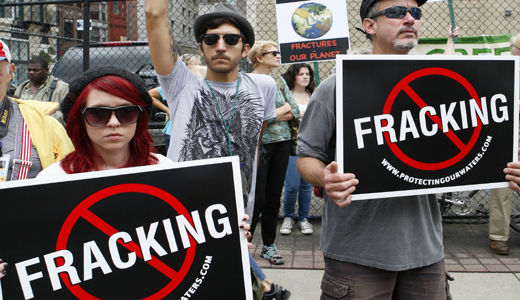
Fracking – a natural gas extraction process – has always been a source of controversy for environmental activists. Now, concerns about the safety of gas drilling in the Marcellus Shale have skyrocketed, in light of a recent scientific study, which concluded that chemicals used in fracking can seep into and poison drinking water far more quickly and easily than previously thought.
The shale is a unit of rock near Marcellus, New York that extends through part of the Appalachian Mountains. It contains largely in-demand natural gas reserves and is considered to be one of the most desirable targets for energy development among those who support the troubling fracking process.
Some 5,000+ wells were drilled in the Marcellus between mid-2009 and mid-2010, according to ProPublica. Fracking operators typically inject around four million gallons of fluid into the ground to drill and frack each well.
In the new study, published three weeks ago in the monthly environmental research journal Ground Water, scientists suggested that, although certain layers of rock would keep the fluid, which contains benzene and other hazardous chemicals, those chemicals would reach the surface within merely a few years, and then taint any nearby water.
Scientists arrived at such a conclusion based on computer modeling, which analyzed the natural faults and fractures in the Marcellus Shale.
Tom Myers, an independent hydrogeologist and author of the study, said, “Simply put, the rock layers [in the Marcellus Shale] are not impermeable. The shale is being fracked into a very high permeability. Fluids could move from almost any injection process.”
Two anti-fracking environmental groups – Catskill Mountainkeeper, and the Park Foundation, both located in upstate New York, funded the study’s research.
Although many environmental activists have protested fracking and continue to do so, there has been little study highlighting their concerns about poisoned groundwater, until now.
The study’s computer modeling also predicted how fracking fluids would move over time, and concluded that fracking will drastically speed up the movement of underground chemicals from previous drilling, drawing them to the surface at a much more rapid rate than initially thought.
To add to the potentially dire consequences of fracking, many fear that chemical seepage isn’t the only problem.
“Responsible analysts point to the more likely contamination routes nearer the surface: incidental spills, failure of casings and concrete, orphan wells, etc.,” said Marcellus Shale Protest.
Myers also noted that the problem extends far beyond the Marcellus Shale, and that areas where fracking is the most frequent will see their groundwater at even greater risk. He adds, “One would have to say that the possible travel times for a similar thing in Arkansas or Northeast Texas is probably faster than what I’ve come up with [for Marcellus].”
Photo: Several activists protest fracking outside the Philadelphia convention center, arguing that the process has polluted air and water and made people sick. Mark Stehle/AP












Comments